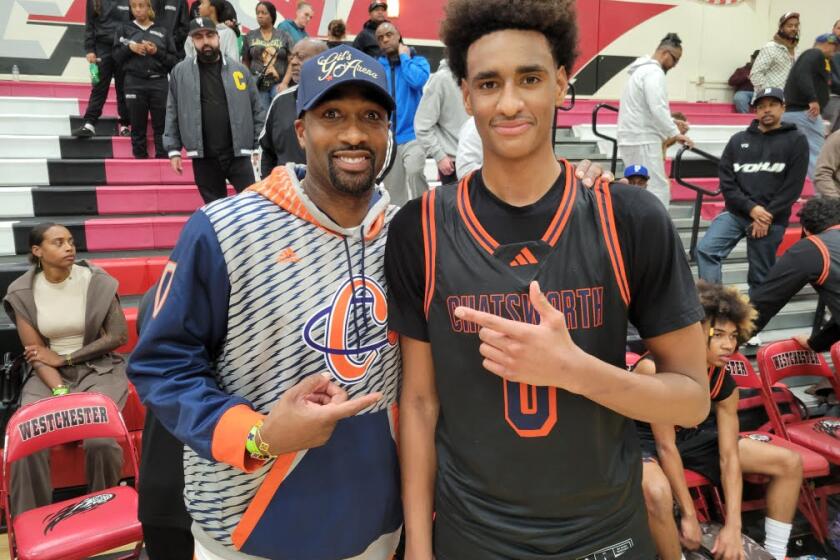ALL’S WELL : Words to Live By for Track Promoter Al Franken--as Long as He Makes the Newspapers
When the telephone rings at 9 a.m. in the days and weeks leading to the Sunkist Invitational, reporters who cover track and field, and even some who don’t, know instinctively who it is at the other end of the line.
“All’s well?” Al Franken asks.
All’s well with Franken, probably the nation’s best-known track and field promoter. Besides the Sunkist, he has also promoted the Pepsi in Los Angeles, the Michelob in San Diego and the Kinney in Berkeley.
But just because he’s well known, that doesn’t mean he’s the most loved. That’s OK, he says. Just spell his name right. Better yet, spell his sponsor’s name right. And often.
Tonight at the Sports Arena, his indoor show, the Sunkist, the oldest track and field meet west of the Mississippi, marks its 30-year anniversary.
Franken, 63, has been associated with the meet, originally known as the L.A. Invitational, for all 30 years, which isn’t a bad record for someone who has twice been suspended for life from promoting meets. Then again, anyone who has seen him land on his feet time after time knows that he has nine lives.
When the history of track and field in the United States is written, a chapter should be devoted to Franken. Yet, he is the first to admit that he knows less about the sport than he does about selling it.
Who needs to know how to throw a javelin? Just get Tom Petranoff to try to throw one across a lake and summon the photographers.
The temptation is to call him Runyonesque . If Damon Runyon’s characters had untamed cowlicks and wore golf shirts, then maybe he is.
He certainly is a throwback to the days when publicity men didn’t work for companies larger than the ones they were representing, weren’t afraid to get a little ink under their fingernails and would do almost anything to get a story in the paper.
Franken understands how that’s done. After graduating from UCLA in the 1940s, he went to work as a sportswriter for the old Los Angeles Mirror before leaving in 1952 to begin a career in public relations. He still knows his way around newspaper buildings.
People who have worked in this one for decades still have to flash their identity cards to the guard every day to gain admission. Visitors are required to sign in. Press releases in hand, Franken just waves to the guard--”All’s well?”--and walks on through.
On one of his recent visits, he announced that he was attempting to sign Ben Johnson to run in the Sunkist. Because of his 2-year suspension for using anabolic steroids in the Olympics, the Canadian sprinter wouldn’t have been able to compete in the open division of the meet. But Franken wanted to enter him in a 60-yard dash against pro football players.
Johnson turned Franken down, but a story about the offer still appeared in a newspaper (not this one). Not particularly thrilled about having their company name linked with a steroid-user, Sunkist officials complained to Franken.
“You would have taken some heat from the press, too, if Johnson had been in your meet, “ Franken was told this week.
“Yeah,” he said, “but the meet would’ve sold out. I don’t care what anyone writes about me as long as they mention my name.”
That’s why Franken could brazenly suggest a pregnant women’s race 3 years ago, when Mary Decker Slaney, usually one of his top attractions, was with child. Obstetricians everywhere were relieved when that failed to materialize.
Franken did once have a shopping-cart race, the winner earning a trip to a local supermarket to fill her cart with free groceries. And he once prodded Larry Doubley, a USC long jumper, to jump over a car. Doubley made it.
But the most spectacular jumper he ever used in a promotion had four legs. Inspired by the sight of a Frisbee-chasing dog at a Super Bowl halftime show, Franken signed the dog to high jump against Dwight Stones. Alas, the dog never cleared a height.
When it was the dog’s turn, his trainer threw a Frisbee over the high jump pit. But instead of jumping over the bar, the dog scooted under it. He did, however, catch the Frisbee.
“The dog wasn’t stupid,” Franken said.
Before his indoor meets in San Francisco, which have been discontinued, Franken was usually able to get photographs in the newspapers by having his milers race cable cars up a hill with Alcatraz in the background.
One year, seeking a different shot, he persuaded the great Australian runner, Ron Clarke, to jog across the Golden Gate Bridge, but Clarke was arrested because the stunt obstructed traffic. Franken had to pay the fine.
Amid the hype, there have been some outstanding meets. Franken’s best was the Sunkist in 1986, when Greg Foster, in the 60-meter hurdles; Billy Olson, in the pole vault; Charlie Simpkins, in the triple jump, and Johnny Gray, in the 880, set world records.
Even the first L.A. Invitational in 1960 had an all-star cast, including pole vaulter Don Bragg, high jumper Charlie Dumas, shotputter Parry O’Brien and hurdler Lee Calhoun.
Before 1960, the established indoor meets were in the East or the Midwest. But with the Sports Arena under construction in 1958, Franken’s mentor, the late Herschel Smith, started thinking about bringing an indoor meet to Los Angeles.
Two years later, they had everything in place except for one minor detail, a track. After a nationwide search, they found one to rent in Milwaukee and had it transported 2,000 miles on a tractor trailer. It arrived the day before the meet.
“We were sold out,” Franken said. “We were concerned about having to make all those refunds if the track didn’t arrive.”
The meet has never had a bigger attraction than the next year, when Wilma Rudolph competed for the first time after winning 3 gold medals at the 1960 Rome Olympics.
“People were literally crashing through the gates and breaking down the doors to get in to see Wilma,” Franken said. “In 30 years, I’ve never seen anything like it.”
Contrast that to 1969, when collegiate athletes, who were the stars of track and field in those days, couldn’t compete against post-collegiate athletes because of the feud between the National Collegiate Athletic Assn. and the Amateur Athletic Union.
With an unspectacular field, the meet drew about 8,000 people. There were concerns about whether it would continue until Sunkist came on board as a sponsor in 1970.
Franken has brought numerous headliners to the Sports Arena. French miler Michel Jazy, the world record-holder at the time, made his only U.S. appearance there in 1962. Making their first U.S. appearances there were Kenya’s Kip Keino, Finland’s Lasse Viren and Czechoslovakia’s Jarmila Kratochvilova.
Houston McTear and Gerry Lindgren were featured as high schoolers. Mary Slaney ran as a 13-year-old junior high schooler.
Among the celebrated matchups have been Jazy against Jim Beatty, Keino against Jim Ryun, Viren against Steve Prefontaine, Clarke against George Young, New Zealand’s John Walker against Tanzania’s Filbert Bayi, Foster against Renaldo Nehemiah, Ireland’s Eamonn Coghlan against Steve Scott.
Not all were as brilliant as advertised. Viren, who won the 5,000 and the 10,000 meters at the 1972 Olympics and would win the again in 1976, finished well behind Prefontaine in 1973 at 3,000 meters.
“We had to keep the doors open so that he could finish,” Franken said.
Franken said that he has formed fast friendships with some athletes. At one time, he had Keino staying in one of his guest bedrooms and Viren in another. Prefontaine was the bartender at Franken’s New Year’s Eve parties.
But he said that his friendship with Coghlan was strained a few years ago because of a dispute over pay. Even though he was ill, Coghlan fulfilled his commitment to run in one of Franken’s meets in San Diego. Naturally, he ran poorly but still wanted to be paid the price that had been agreed upon earlier. Franken wanted to cut him by half.
“It was a gray area,” said Franken, who finally met Coghlan’s demands.
A lot of athletes have stories to tell about difficult negotiations with Franken. Many of them say they will never run for him again. Most of them do if he gives them their price the next year.
Says Franken: “Today, friendship means, ‘How much can you pay me?’ ”
But money isn’t new to the sport, even if being able to pay it to the athletes legally is. Even when it was against the rules, Franken said that he never had one athlete who turned down a few dollars slipped under the table.
“If I was going to make some money, I felt the athletes should get part of it,” he said.
Franken never cared much for the rules. In 1954, he arranged for miler Wes Santee to get two plane tickets to the California Relays at Modesto. The AAU suspended Franken and Santee for life. The suspension stuck against Santee but not Franken. “They couldn’t enforce it,” he said.
The AAU went through the motions of suspending Franken again in 1966, when he negotiated directly with Keino. According to its rules, the AAU was supposed to act as the agent for foreign athletes competing in the United States.
When Keino arrived in Los Angeles, the AAU’s executive director, Ollan Cassell, met him at the airport to tell him that he couldn’t run in Franken’s meet. Keino ignored him and ran. Franken has nothing but fond memories of Keino. Franken can also recall the phone number he would use to reach Keino in Kenya. Kajanga-4.
“When Keino first ran here in 1966, I had him in the mile,” Franken said. “He ran a terrible race and lost to a young unknown named John Lawson. Keino was so chagrined that he demanded to run in the 2-mile, which he won.”
The next great Kenyan to run for Franken was Henry Rono, although he almost didn’t. When the starters for a 2-mile race were announced, Rono wasn’t on the track. He was sitting in the stands. But when he heard his name called, he hurried to the starting line and, without warming up, won the race in a fast time.
That was a happier ending than one of Franken’s experiences with Martin McGrady, who was known as the Chairman of the Boards before Coghlan. McGrady once called Franken from the airport and asked for transportation to the meet. He was supposed to run the 500 meters. Franken had to tell him the race was run 30 minutes earlier.
If nothing else, it has been an education for Franken. A Soviet interpreter, who was accompanying athletes, once told Franken’s wife that everyone in the Soviet Union knows that the United States keeps it poor people under the freeway overpasses.
“We’ve survived because we don’t take ourselves too seriously,” Franken said. “Anytime you can do something for 30 years, make a living and enjoy yourself, what else can you ask for?”
More to Read
Go beyond the scoreboard
Get the latest on L.A.'s teams in the daily Sports Report newsletter.
You may occasionally receive promotional content from the Los Angeles Times.










